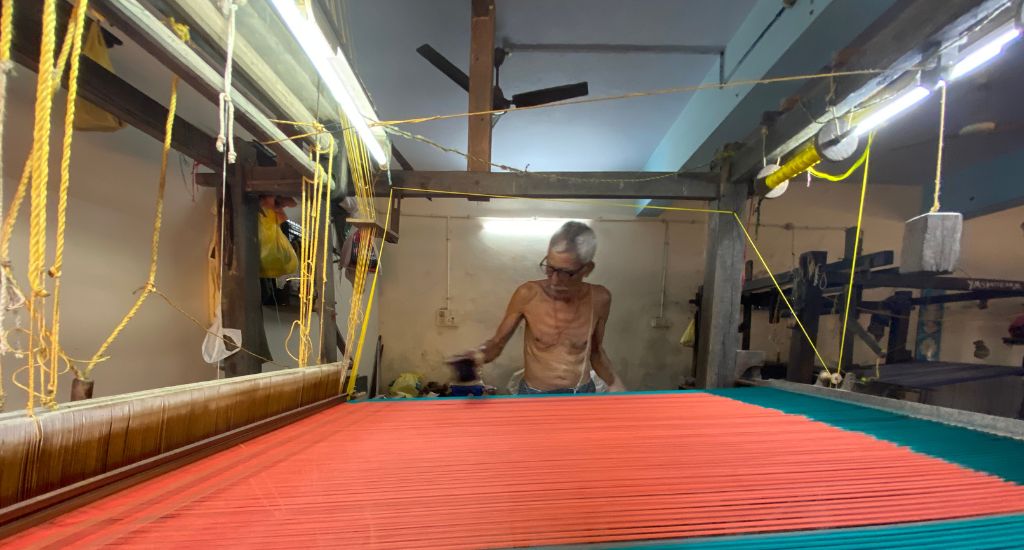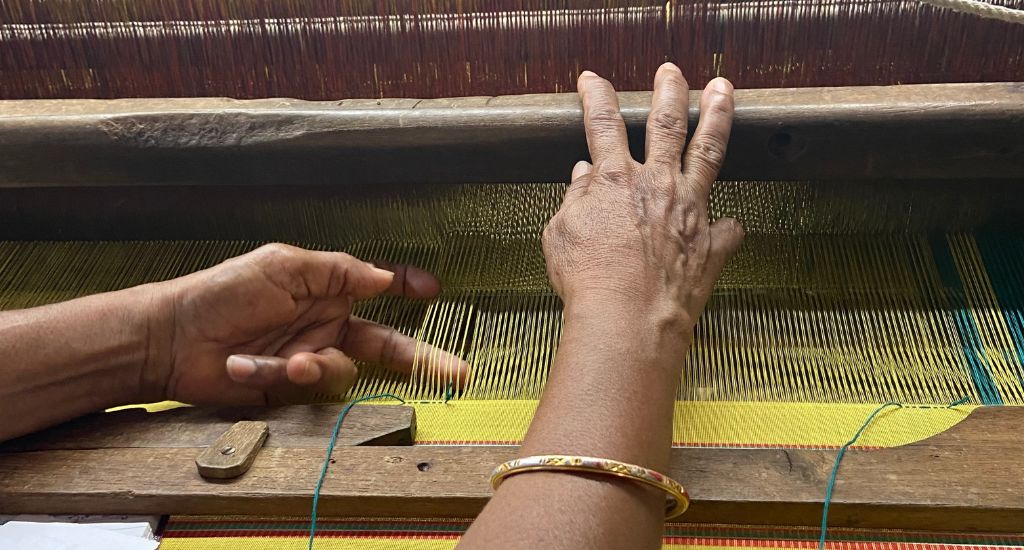
Karnataka weavers of Udupi sarees face heat over heatwaves
Climate change is adversely impacting weavers of the globally acclaimed sarees as the starch they use is drying up too quickly due to rising temperatures.

Climate change is adversely impacting weavers of the globally acclaimed sarees as the starch they use is drying up too quickly due to rising temperatures.
Climate change is having a global impact, from triggering unseasonal rains and storms to causing prolonged dry spells and droughts. It has not spared even the famous Udupi sarees that are woven in Karnataka and are acclaimed worldwide.
This summer, in March to be more precise, weavers watched in horror as the starch they use in their looms dried too quickly, not allowing them to separate the strands of thread that are finally strung together to make the sarees.
Starch made from boiled rice gruel is an important component in the weaving process of the sarees. Weavers apply them to spin their yarn.

“If you apply too little, the thread breaks. If you apply too much, the threads stick to each other and the saree gets damaged,” said Shantha, a veteran weaver of Udupi sarees.
As a member of the Talipady Weavers’ Society in Kinnigoli, some 32 km from the port city of Mangalore, she has been weaving Udupi sarees for the past four decades.
But nothing had prepared her for what the weavers faced in the oppressive heat of this March.
The starch they applied dried too quickly, not allowing them to separate the threads and weave the sarees. Besides slowing down production, they lost money as well, since weavers are paid against the meters of yarn woven.
The weavers were all surprised by the new phenomenon. But few had answers.

This was the first time Mamatha Rai, the president of Kadike Trust which is a non-profit that has been working for the revival of Udupi sarees, had witnessed such a thing.
“I have often heard them complain in the rainy season when the starch wouldn’t dry fast. But this is the first time I heard them complaining about the opposite.”
So, what happened?
Experts at the Indian Meteorological Department (IMD) say the reason for the unusual drying up of starch that stalled production could be because of the climate crisis.
In early March, the IMD had warned of an impending heatwave in coastal districts of Karnataka. It was a historical warning in the sense that the Dakshina Kannada district had never been witness to heatwave warnings before.

True to the warning, temperatures soared across the region, topping 39 degrees Celsius. Forest fires erupted intermittently too with calls to emergency services multiplying. There were as many as 30 calls per day towards the latter half of March.
Complaints from the weavers peaked as well during the period.
“The heatwave in March can be attributed to both climate crisis and the failure of western disturbances,” pointed out A Prasad, a scientist at the Bengaluru regional center of the IMD.
Western disturbances are storms originating in the Mediterranean region that brings rain to northern India. It consequently cools down temperatures in many parts – including Karnataka on the west coast. This year though has been an aberration with rains being elusive. It resulted in heatwaves which recently caused 14 deaths at a public rally in Maharashtra.

According to a new study published by researchers at the University of Cambridge, over 90% of India is in danger of being adversely affected by heatwaves. It also points out that the Climate Vulnerability Index (CVI) that the Indian government relies on may be underestimating the adverse effects of heat waves.
However, weavers of Udupi sarees are already facing the heat of heatwaves.
Sizzling summers are ominous for them. More so because the phenomenon is unfolding amid a resurgence in the popularity of Udupi sarees.
Some few years ago, the sarees were on the verge of extinction with weavers leaving their profession in hordes for greener pastures. But then a turnaround happened, courtesy aggressive marketing campaigns on social media. Soon, it shed its reputation as a ‘saree for old women’ and became a kind of fashion statement.

The demand for it grew exponentially and the weavers began to return. “More women started coming after we started our work with the society to market the sarees better,” explained Mamatha.
But extreme heat is threatening to play a spoilsport.
“Economic, social and cultural losses would be the consequences of the climate crisis,” explained Dr N H Ravindranath, a former professor at the Centre for Sustainable Technologies of the Indian Institute of Science in Bangalore.
The crisis places the weavers in a spot. If they were to think of replacing starch, Udupi sarees would not remain Udupi sarees any more. One of the features specified under its Geographical Indication (GI) tag is the usage of starch instead of any chemical agents. It is something that the sarees simply cannot afford to forgo – heat or no heat.
The unprecedented heatwaves are a headache for the weavers.
The lead image at the top shows a weaver applying starch using a brush made from fishtail palm tree (Photo by Amulya B)
Amulya B is a multimedia journalist, writer and translator based in Bengaluru. Her stories explore the intersection of culture, society and technology. She is the winner of Toto Funds the Arts for creative writing and Laadli Award. She is a Rural Media Fellow 2022 at Youth Hub, Village Square.